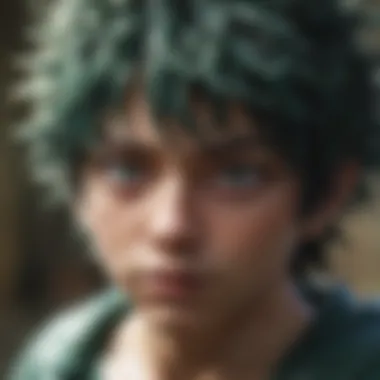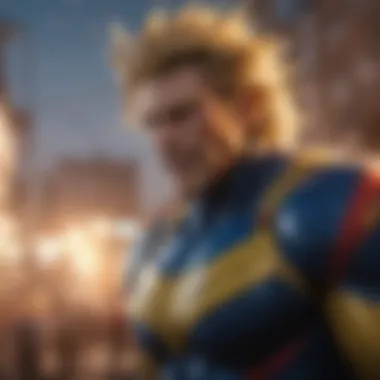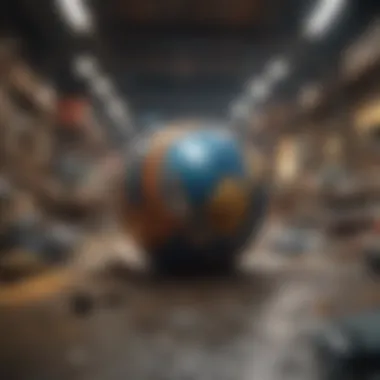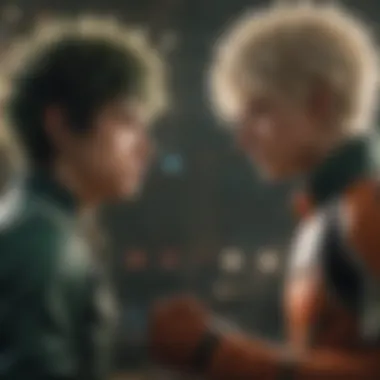Exploring My Hero Academia Season One: Episode One


Intro
The world of the superhero has seen a fresh perspective with the emergence of My Hero Academia, a series that tweaks the traditional norms surrounding heroes and villains. It kicked off its journey with the first episode that aired in 2016, quickly captivating audiences with its unique blend of drama, action, and humor. This anime does not merely present a story about superpowers; rather, it layers thematic complexity with rich character development, all while embracing the essence of coming-of-age narrative style.
Spike your curiosity as we unpack the first episode, from its pivotal moments to the intricate character arcs that lay the groundwork for what is to come. This analysis is not merely a summary; it aims to delve into the details that make My Hero Academia a standout within a crowded industry and resonate with both casual viewers and devoted fans alike.
Industry Insights
Emerging Trends in Anime Industry
The anime landscape has changed a lot in recent years, almost like a chameleon shifting colors to adapt to its surrounding. My Hero Academia, in particular, represents a growing trend where the genre is venturing into more inclusive and diverse storytelling. Instead of just focusing on a singular protagonist, the narrative weaves a tapestry of various characters, each dealing with their own struggles and ambitions.
This trend can be seen in many upcoming series where themes of collaboration and teamwork take center stage. Viewers are increasingly drawn to plots that reflect the complexities of modern society, and My Hero Academia is a perfect example, addressing issues like self-worth, societal expectations, and the path to achieving one's dreams.
Latest Trends in Comic Industry
In connection with these anime narratives, the comic industry isn’t lagging behind. With a rise in superhero-themed stories that focus on personal growth and ethical dilemmas, comics are seeing a similar evolution. Series that twist heroism to incorporate real-life challenges, like mental health or social justice, are gaining traction, reflecting a cultural shift towards a more involved and aware storytelling.
"The superhero genre is not just about power; it's about responsibility and growth."
This sentiment rings true in My Hero Academia. The lead character, Izuku Midoriya, embodies the struggle between aspiration and reality, serving as a mirror to real-world challenges faced by young adults today.
Reviews & Recommendations
Must-Watch Anime Recommendations
For fans of superhero narratives or anyone delving into anime for the first time, My Hero Academia is essential viewing. However, there are also other titles worth mentioning:
- One Punch Man: A satirical take on the superhero genre that offers a fresh perspective.
- Attack on Titan: Brimming with intense action and deep moral questions about humanity.
- Demon Slayer: A beautifully animated series that explores familial bonds and personal sacrifice.
These series, like My Hero Academia, offer a unique mix of character-driven plots and high-stakes narratives, carving out their own distinct place in the anime lexicon.
Movie/TV Show Reviews
While My Hero Academia is celebrated in the anime arena, its impact stretches beyond television into films and video games. The adaptations keep the essence of the original series while expanding on story arcs, drawing in both existing fans and newcomers through compelling narratives.
News & Updates
Breaking News in Comic Industry
With the continuing popularity of My Hero Academia, news about upcoming seasons or movie adaptations remains a hot topic among fans. They're constantly speculating on character developments, new power reveals, and potential plot twists that could decide the fate of these beloved characters.
Finale
As we transition from discussing characters to diving into story arcs in the upcoming sections, it’s clear that the first episode of My Hero Academia sets a solid foundation for what lies ahead. With a blend of humor, chaos, and the exploration of profound themes, it unmistakably leaves its mark on anime and pop culture as a whole.
Prolusion to My Hero Academia
My Hero Academia, also known as Boku no Hero Academia, has carved its unique niche within the crowded landscape of anime and manga. It is crucial to understand this series, especially its premiere, because it sets the foundation for everything that follows. The initial episode captures a world where the concept of heroism is woven into the very fabric of society. This is not just a story about superheroes; it explores themes that resonate on a deeper level, such as dreams, perseverance, and the struggles of character development.


Overview of the Series
My Hero Academia launched in 2016, adapted from Kohei Horikoshi's manga, quickly becoming a cultural touchstone. In a society flooded with superpowers, or "quirks," the story revolves primarily around Izuku Midoriya, a quirkless boy who aspires to become a hero like his idol, All Might. The series artfully blends action and heartfelt moments, showcasing not just the battles between heroes and villains but also the everyday trials faced by individuals.
From the onset, the show distinguishes itself with richly crafted characters. Midoriya’s evolution from an insecure youth to a determined aspirant is incredibly relatable. The series encapsulates the formative journey of youth caught amidst societal expectations and personal goals. This underlying emphasis on growth makes it a captivating watch for a broad audience.
Cultural Impact of the Franchise
The impact of My Hero Academia cannot be overstated. It has emerged as a global phenomenon, influencing not only the anime industry but also mainstream pop culture.
- Fandom and Community: The series has fostered a large and active fanbase, evident on platforms like reddit.com where discussions thrive about theories, character relationships, and future arcs.
- Merchandising and Collaborations: From action figures to clothing lines, its merchandising reflects its popularity, making heroes and villains household names worldwide.
- Themes in Real Life: The show’s poignant themes of resilience, gratitude, and the fight against adversity resonate with many. Fans often apply the lessons learned from Midoriya’s journey to their own lives, whether as students or professionals.
The widespread enthusiasm for My Hero Academia illustrates its role as more than entertainment; it serves as a beacon of inspiration for many.
In summary, the introduction of My Hero Academia is not merely about presenting characters within dramatic scenarios. It delves into the essence of being human, casting a wide net that catches the hearts of its viewers. As we proceed further with our analysis, understanding the introduction will help frame the depth of character development and thematic elements present in the very first episode.
Episode One: A Comprehensive Overview
Understanding the first episode of My Hero Academia is crucial, as it sets the tone for the entire series. This initial chapter lays the groundwork for character arcs and thematic explorations that run through the anime. By dissecting this episode, we can appreciate how it introduces viewers to a world filled with heroes and quirks, creating a strong emotional connection between the characters and the audience. It also highlights the potential for growth and resilience in a society that often overlooks those without powers.
Setting the Scene
The opening scenes of My Hero Academia plunge viewers into a world where superpowers called "quirks" are common, shaping societal norms and expectations. From the get-go, the show opens with a brisk montage, illustrating the prevalence of quirks. This well-crafted introduction not only piques interest but also establishes the stakes for those without these abilities. The juxtaposition of the ever-heroic world against Midoriya's struggles draws viewers into his personal plight. It suggests that heroes are not just born; they're made through determination and hard work.
This backdrop emphasizes a critical point—those lacking powers should not feel lesser; instead, they can pursue their ambitions against the grain of societal expectations.
Main Characters Introduced
Midoriya Izuku
Midoriya, often seen as the embodiment of the underdog, stands out due to his unwavering will to achieve his dreams. His initial presentation as a quirkless boy fosters instant sympathy from the audience, making his journey relatable. What makes Midoriya a pivotal character is his deep admiration for heroes, especially All Might. His ability to resonate with viewers stems from his genuine vulnerability and relentless determination. His moment of despair mixed with aspiration feels like a breath of fresh air in the superhero genre.
However, this quirkless trait presents a unique challenge that shapes his development. His struggle creates a dynamic that invites viewers to reflect on their own dreams and the obstacles they face.
All Might
The introduction of All Might, the symbol of peace, adds another layer to the overall narrative. He is not only a mentor but also a benchmark against which Midoriya measures his potential. All Might's characteristic smile and larger-than-life persona serve to inspire those around him. He isn’t just a hero; he’s a beacon of hope and hardiness in a world teeming with peril.
A key aspect of All Might's character is his vulnerability hidden behind his heroic facade. The contrast between his public image and personal struggles makes him a more multifaceted figure, showcasing that even the strongest need to confront their challenges. This nuance contributes to the depth of the show's narrative, making it popular with fans who enjoy layered storytelling.
Supporting Cast
The supporting cast in Episode One is introduced as necessary elements that enrich Midoriya’s world. Characters like Bakugo, who epitomizes rivalry and conflict, challenge Midoriya's aspirations while illustrating the complexities of relationships in a competitive environment. This rivalry feels authentic, as it resonates with common experiences in schools and society.
Furthermore, characters such as Iida and Uraraka add texture to Midoriya’s journey. Their varied quirks and personalities not only provide comic relief but also pose different paths of heroism, emphasizing that everyone’s journey is unique. Each of these characters accentuates different themes of friendship, competition, and growth, contributing to the episode's overall narrative strength.
In this way, the supporting cast proves to be an essential feature of the series, creating opportunities for various character arcs and interactions. This layered storytelling serves as a beneficial element that enhances both viewer engagement and narrative development, reflecting the show's ambitious scope.
Character Dynamics and Development


The character dynamics and development in the first episode of My Hero Academia lay the very foundation for the series' broader themes and emotional impact. Understanding how characters interact with one another reveals their underlying motivations and drives the narrative forward. This segment explores how pivotal relationships shape the protagonist, Izuku Midoriya, and set the stage for the larger conflicts that will unfold throughout the series. By examining these dynamics, we grasp the essence of heroism, the fear of inadequacy, and the struggle against personal demons that many viewers resonate with.
Midoriya's Journey Begins
From the get-go, Midoriya's character serves as a mirror reflecting the trials faced by those who dare to dream. A quirkless boy in a world filled with individuals boasting extraordinary abilities, Midoriya struggles with feelings of inadequacy. His journey begins not with triumph but with vulnerability, perfectly captured in a poignant scene where he laments never having a quirk of his own. This immediate sympathy for Midoriya establishes a crucial connection between him and the audience.
His determination, despite countless setbacks, showcases a critical theme: that the lack of inherent talent doesn't preclude one from aspiring to heroism. This nuanced character arc is compelling as it invites viewers to reflect on their aspirations and the obstacles they face in their lives.
The Symbol of Peace: All Might
All Might represents the quintessential hero, embodying the ideals of strength, hope, and inspiration. However, his character is multifaceted; beneath his robust exterior lies a vulnerability tied to his burden of being the world's strongest hero. The juxtaposition of his heroic persona with his true self, a frail individual dealing with the consequences of his past, offers depth to the archetypal hero character.
His relationship with Midoriya acts as a cornerstone for the show's exploration of mentorship and legacy. When All Might takes Midoriya under his wing, it not only illustrates the transfer of hope but also indicates that true strength can arise from unlikely sources. This dynamic lays a rich groundwork for Midoriya’s transformation as he adopts All Might's values in his quest.
Friendships and Rivalries
Bakugo Katsuki
Bakugo serves as both a catalyst for Midoriya's growth and a representation of the darker side of heroism. Often perceived as brash and arrogant, Bakugo encapsulates the idea that ambition can sometimes lead to toxic behavior. His rivalry with Midoriya is not merely about competition; it's steeped in their contrasting approaches to heroism.
While Midoriya embodies resilience and empathy, Bakugo represents raw talent and aggression. This rivalry becomes a necessary counterbalance, pushing both characters to evolve in their own ways. Furthermore, Bakugo's complex character invites viewers to question what it takes to be a hero. Is it simply about strength, or is there a need for emotional intelligence and compassion? This contradiction adds a fascinating layer to the discussion of hero dynamics within the series, enhancing its relatability.
Early Relationships
The early relationships in My Hero Academia serve as a lens through which we can analyze the social landscape of U.A. High School. Midoriya's interactions with classmates like Ochako Uraraka and Shoto Todoroki not only contribute to his personal growth but also enrich the narrative. Each character showcases varying aspects of ambition and dreams, from Uraraka's desire to support her family financially to Todoroki's struggle to break free from family expectations.
These interactions underscore the importance of teamwork, camaraderie, and even conflict within the journey toward becoming a hero. The tangled web of relationships reflects the complexities of youth, highlighting that heroism is not a solo venture but rather a shared endeavor, filled with both support and rivalry. This intricate portrayal allows viewers to appreciate the depth of relationships and their role in shaping heroes and villains alike.
"In a world filled with quirks, the most powerful gift is the bond between people."
The examination of character dynamics and development in the first episode primes the audience for the complex narratives that will unfold in My Hero Academia, highlighting that the adventure of becoming a hero is intertwined with understanding oneself and the connections we foster along the way.
Themes and Motifs
The importance of themes and motifs in the first episode of My Hero Academia cannot be overstated. They lay the groundwork for understanding the emotional undercurrents and character motivations that define the series. The themes brought to life in this anime resonate not just with the characters but with fans globally, connecting them through shared experiences and societal critiques. This analysis focuses on three primary motifs that emerge early on: the nature of heroism, the impact of bullying, and the pursuit of dreams.
The Nature of Heroism
From the outset, My Hero Academia introduces audiences to a world where heroism is not only revered but intricately complex. The essence of heroism is explored through characters like Midoriya Izuku, who embodies unwavering resolve despite his initial lack of powers. The narrative asks: What does it truly mean to be a hero? In Midoriya's case, it’s about persistence, empathy, and self-sacrifice, suggesting that intrinsic qualities matter far more than any superpower.
All Might, as the symbol of peace, further complicates this definition. His larger-than-life persona and zest for justice serve as both inspiration and a standard for what a hero should aspire to be. The episode highlights the duality of heroism—showcasing moments of vulnerability alongside heroic acts. This juxtaposition makes the character relatable and reinforces the message that even the strongest heroes struggle and grow.
"A hero's journey is often paved with mistakes and learning; it is not an easy road, but it's always worth it."
Bullying and Resilience
Another critical theme that emerges is the harsh reality of bullying. Midoriya faces relentless bullying from Bakugo, which acts as an engine for his character development. It raises important questions about how individuals cope in environments that are hostile and unforgiving.
The series does not shy away from the painful aspects related to bullying. It illustrates how it can galvanize one's desire to grow stronger, pushing Midoriya to seek affirmation through resilience. This theme provides an essential layer to the story, making it so much more than a typical superhero tale. Instead of depicting heroes solely as saviors, the narrative brings forth the reality of personal struggles, emphasizing emotional endurance as a pivotal trait for heroes.


Dreams and Aspirations
Dreams are woven into the fabric of My Hero Academia, particularly in how they drive characters to pursue their ideals. Midoriya is obsessed with becoming a hero like All Might, echoing the dreams many hold for their future, even in the face of adversity. The episode encapsulates the fear of failure—something that resonates with viewers who harbor their ambitions.
Moreover, the clash between ambition and ability is poignantly illustrated. Midoriya’s dreams clash with the reality of being quirkless in a world that prioritizes superpowers. This conflict not only humanizes him but also endears him to the audience as they root for his journey against all odds. The narrative conveys that while dreams can be elusive, the passion to pursue them is what defines one’s character.
In summary, the exploration of these themes and motifs in the first episode lays the foundation for understanding the intricate world of My Hero Academia. They serve as critical elements that enrich character arcs and resonate with viewers' personal experiences, providing a fertile ground for deeper discussions as the series progresses.
Visual and Audio Elements
In any visual storytelling medium, the presentation significantly shapes viewers' perceptions and emotional connections with the narrative. My Hero Academia is no exception to this rule. The visual and audio elements weave a rich tapestry that enhances the viewer's experience, drawing them deeper into its world. These components set the stage for understanding character development, themes, and the overall tone of the series. This section delves into the nuances of the animation style and the carefully crafted soundtrack that contribute to the show's acclaim.
Animation Style
The animation in My Hero Academia is a standout feature that undoubtedly merits attention. Produced by Studio Bones, the visual style is marked by vibrant colors and dynamic action sequences that captivate the audience's eye. Character designs are not only unique but also expressive, reflecting their personalities in a way that blends seamlessly into the overall aesthetic of the show.
Particularly notable is the way the animation utilizes fluid motion during fight scenes. These sequences are not just for show; they echo the characters' motivations, personalities, and even their struggles. The clinching moment when Midoriya first attempts to harness his power beautifully captures his fear and determination through meticulous attention to the movements.
Moreover, lighting plays a crucial role. Darker scenes often illuminate the tension and stakes involved while brighter scenes highlight moments of hope, success, or camaraderie among characters. Every frame is carefully crafted to influence the emotional weight of pivotal scenes.
Soundtrack and Score
Equally important is the auditory experience, wherein the soundtrack and score elevate the viewing experience to another level. The music in My Hero Academia complements the visual storytelling, underscoring key moments with a well-timed score that heightens tension or elicits emotion.
The opening theme, "The Day," performed by Porno Graffitti, sets an energizing tone from the outset. It encapsulates the theme of aspiration and determination that permeates Midoriya's journey. In contrast, the background score during critical scenes utilizes both orchestral arrangements and electronic elements to evoke a sense of urgency or introspection. This blend creates an atmosphere where the viewer can almost feel the heartbeat of the characters.
For instance, during crucial moments of Midoriya's struggle, the score swells in a manner that mirrors his inner turmoil. The soundtracks are not merely background noise; they are integral to how the story unfolds, guiding the viewer's emotional responses to the events on screen.
"A compelling soundtrack can be the difference between simply watching a story and experiencing one."
Overall, the animation and audio elements of My Hero Academia are not just complementary; they are essential components that bring the narrative to life. By analyzing these features, we can appreciate how they enhance the characters' journeys and the thematic depth, providing glimpses into the emotional landscape the series aims to portray.
Ending and Implications for the Series
Reflecting on the first episode of My Hero Academia, it's clear that what we've witnessed goes beyond mere animation; it's a vibrant introduction that sets the stage for an extraordinary tale. The implications of this episode extend deeply into the series, showcasing how it carves out the essentials of character development and storytelling themes that will resonate throughout all subsequent arcs.
In this foundational episode, various threads are established which bind the storyline together. It’s where viewers first meet Midoriya Izuku, a boy without powers in a world that revels in superhuman abilities. This scenario instantly creates a sense of empathy and relatability, as many might have felt like outsiders at one point. The struggles he faces are representative of the broader human experience, showcasing resilience in the face of adversity.
Another profound aspect here is the introduction of All Might, the symbol of hope and strength. He isn't just a character; he’s an ideological anchor for Midoriya's journey and the audience's expectations. His influence turns Midoriya’s aspirations into a tangible goal, setting a narrative tone filled with ambition and drive. This synergy between characters indicates that future episodes will dive deeper into the mentor-student dynamic, leaving audiences curious about how these relationships will evolve.
Setting the Tone for Future Episodes
The premiere of My Hero Academia serves a dual purpose: it both captivates and establishes groundwork for the journeys to come. Structurally, one cannot overlook how the episode introduces both comedic elements and serious undertones side by side. By balancing light-heartedness with heavy themes, it not only entertains but also prepares viewers for a story that will tackle more complex themes, like justice, morality, and friendship. This first impression is crucial as it communicates that the series doesn't shy away from hard-hitting topics, despite its superhero coat.
"Every hero's journey starts with a single step, often plagued by doubt. If Midoriya can dream, so can anyone."
Encouragingly, the episode allows viewers to share in Midoriya’s emotional turmoil. As he navigates his way through a world that often ridicules him, the audience is invited to root for his triumphs, which creates an emotional investment crucial for long-term engagement. The tone that is set here is especially important as it builds the promise of growth and transformation, making future developments not just expected, but eagerly awaited.
Legacy of My Hero Academia
The first episode marks the foundational stone of a franchise that has since become a cultural phenomenon. By tapping into the essence of the hero’s journey, My Hero Academia has redefined what it means to be a hero in the modern age. The infusion of traditional anime elements with contemporary narratives crafts a legacy that speaks to the struggles and aspirations of youth today.
As a series rooted in personal battles and philosophical questions about heroism, it intertwines its narrative threads deeply with societal values. The exploration of concepts like bullying, resilience, and dreams resonates with diverse audiences, marking its territory not merely as mere entertainment, but as a cultural commentary.
It’s significant to note how its legacy continues to shape both viewers and aspiring creators. This first episode sets a benchmark for storytelling, character depth, and thematic exploration that influences the anime industry as a whole. Its impact can be measured not just in viewer numbers but in the conversations it sparks about character roles, moral choices, and societal responsibilities among fans in pop culture spaces, including forums like reddit.com.
In deposition, the conclusion of this episode doesn’t just signify the end of a single narrative thread; it unfolds into a larger fabric of interconnected stories that speak to what it truly means to stand tall in the face of adversity, making My Hero Academia a timeless piece in the ever-evolving tapestry of anime.



